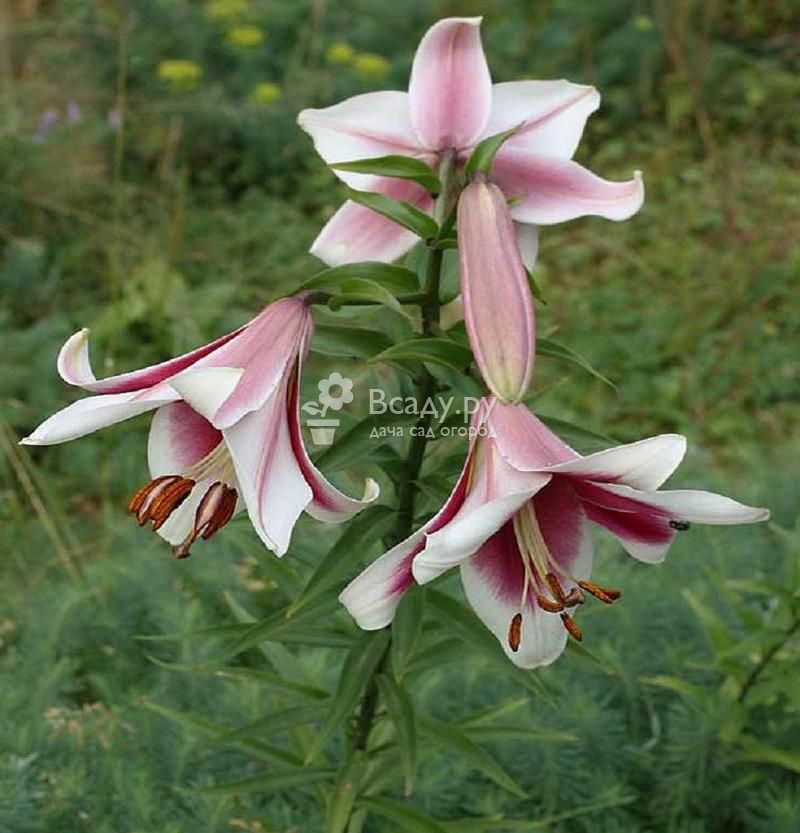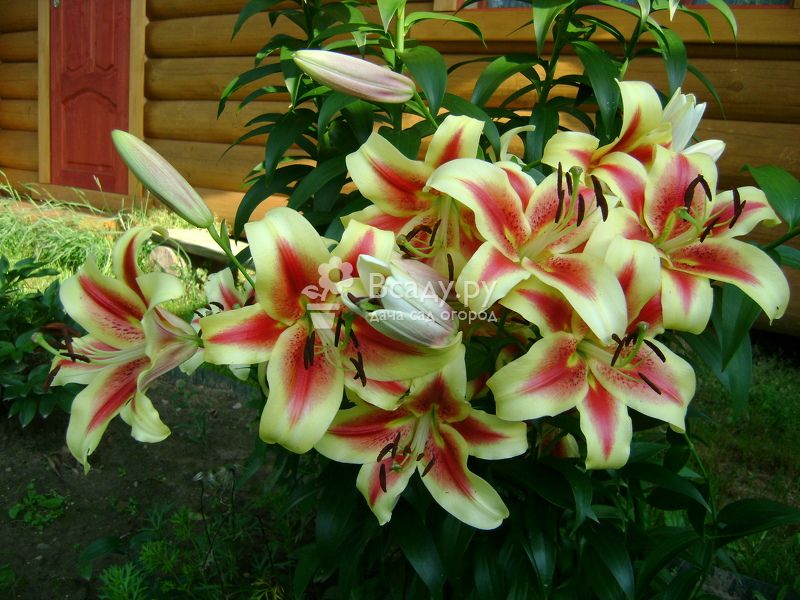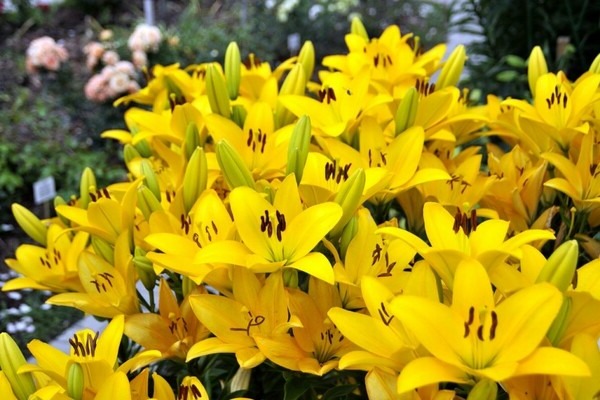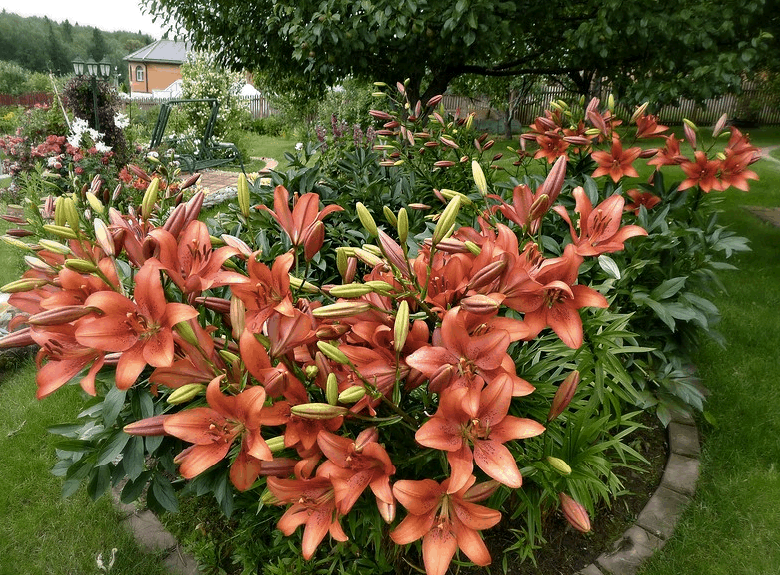Hybrid Group Oriental Trumpet
Tubular and Oriental lily species were taken by breeders to develop hybrid varieties of the Oriental Trumpet group. Large flowers are brightly colored in various shades. Flowers are located in groups of 12-15 pieces.
Black Beauty
One of the first to represent the group, which includes OT hybrids, the Black Beauty lily variety, its photo is amazing, but does not convey all its beauty. A high, up to 2 m stem bears many buds. The flowers are turban-shaped, painted in cherry color with a greenish spot at the base and a white edging. Dark papillomas are present on the petals.

Northern Carillon
This lily variety can be safely called legendary. For many years, it was considered the best OT hybrid in Canadian breeding. In spring, the leaves of this lily are crimson. The flowers are drooping, white with a bright crimson center. One stem has up to 20 flowers, the size of which can reach 30 cm in diameter.

Shocking
Stems 80-100 cm in height are leafy. The flowers are multiple muted yellow or peach in color with bright red strokes. The throat of the flower is light green with red specks. Lilies of the variety, the photos of which are presented below, will make a splash in your garden.

Grow a lily tree? Almost
Almost every season, sellers lure gullible gardeners with bush, curly, or some other unthinkable polyploid lilies. And lily trees are a completely stable lure for naive summer residents. But myths do not arise from scratch and always have something under them.
But, I repeat, this was not invented by lily producers, not hybridizers (they somehow cannot afford this, otherwise ridicule from colleagues cannot be avoided), but dealers, that is, trade intermediaries between the authors of varieties and buyers.
They can almost be trees
When I first saw the gigantic lilies, their luxury was a great shock to me. It was so. In 2005, the first varieties of OT-hybrids appeared on sale and began to come to us. I advised one of my acquaintances to start growing cut lilies for sale. She planted the bulbs in the greenhouse and naturally looked after them properly.
The result was amazing! I saw in full splendor, under two meters high, the luxurious ‘Vina Del Mar’, ‘Veronese’, ‘Velasquez’, ‘Valparaiso’. The beauty is extraordinary, but, alas, they were so big that it was impossible to sell or even deliver them. But to grow huge lilies without a greenhouse - oh, how you need to try.
You can try with these
Based on my experience and not the opinion of my friends lily growers, I will say that you can get giant lilies, but only from varieties of OT hybrids. The ‘Friso’ can be more than two meters, and even in the harsh St. Petersburg climate, it can be grown this size. The fine ‘Scheherezade’ can also be very large. The bright orange 'Saltarello' grows under two meters. The dark crimson beauty 'Miss Feya' is one of the latest in our gardens, so only in hot summer can we show her at the lily exhibition.
The varieties from Canada ‘Northern Carillon’, ‘Northern Sensation’ are also huge. Well, the famous variety, the first ‘Black Beauty’ OT hybrid, can also be more than two meters. But you need to try very hard with it, in our climate you need to wait more than one year until the bulb accumulates enough strength. In hotter climates, these problems do not occur and lilies grow much better.
Often unscrupulous sellers offer huge bulbs and assure that trees will definitely grow from them. However, under the guise of OT hybrids, they sell LA hybrids or Oriental.
A lot depends on the diet
Only a large, mature bulb can produce a large plant. Therefore, you will have to wait until the bulb becomes the size of a fist and accumulates enough strength to give out a giant lily. The bulb, from which they expect to get a "tree", is best planted in partial shade, this will slightly stretch the plant in height.
But the most important thing is the substrate.I recommend making a soil mixture for lilies from vermicompost, sand and coniferous litter. Why litter? Lilies, in addition to tubular and candidum hybrids, love slightly acidified soil, the pole of the needles makes the soil looser, and the looseness of the soil is an important component of success. If the fingers are spread easily into the soil and reach the bulbs, the structure of the soil mixture is ideal.
They begin to feed lilies from the beginning of May, not earlier. I do not share the opinion that the first feeding should be done in the snow. The appearance of the stem and the fluffing of the leaves are a sign that the roots have begun to work and are able to assimilate the introduced nutrition. To carry out top dressing earlier, in my opinion, is pointless.
So, at the beginning of May, we feed two or three times with calcium nitrate, it promotes the opening of membranes and better penetration of nutrients. Then again, two or three times with complex fertilizer (I prefer a universal water-soluble fertilizer like "kemira"). Ten days before flowering, at the stage of staining the buds, I add potassium magnesium. Indeed, before flowering, the lily consumes nitrogen and potassium, and during - potassium and magnesium.
Well, after flowering, we begin to prepare the lily for the next season. And here feeding with potassium monophosphate is very important, I spend them twice - in August and in September.
So it is quite possible to grow gigantic lilies, you just have to try - both feed and drink tirelessly, since there is more lilies than they need, they will not eat or drink.
Main characteristics
Very often, lilies in general and OT hybrids in particular are sold as lily trees, the number of inflorescences of which reaches hundreds of flowers. In fact, all botanists agree - there are no such varieties. Even so, the merits of OT lilies are incredibly diverse. This variety has a number of advantages that distinguish them from the whole variety of the lily kingdom.
-
Height. There are varieties of OT hybrids, which after a few years after disembarkation grow to incredible sizes - more than a meter, sometimes even up to one and a half meters. Therefore, this species looks great in landscape design, especially in a company with undersized varieties.
-
Original flowering. Such cascades with many inflorescences undoubtedly look luxurious and amaze with their magnificence and aroma.
-
Resistance to pests, diseases. Winter hardiness in many varieties is high, but shelter is required for the period of cold weather.
Reproduction
The plant propagates with bulbs or seeds. It depends on its type, characteristics of growth and development in an artificially created environment. The bulbous way of dividing is the most common.
The flower, germinating in the ground for about 3-4 years, begins to wither gradually. This is due to the fact that he needs to get rid of the babies on the bulb. Such formations are separated by hand, without the use of sharp instruments. They are planted separately and watered regularly until sprouts hatch.
Seed propagation is rare, since flowering has to wait up to seven years. Long seeds are separated from the flowers, similar to small thin sticks. Sowing is carried out in February-March, germinated warm until winter. Then rearranged to a cool room. In the spring they are transplanted into the garden.
Description of OT hybrid lily
The hybrid belongs to perennial herbaceous plants. It turned out as a result of crossing of two species - Eastern Oriental and Tubular. This hybrid group today is one of the most promising and demanded, especially in Russia, because of the climatic conditions suitable for it.
The bulbs are the planting material for OT hybrids of lilies. In diameter, they are approximately from 1 to 30 cm (this will depend on the variety). Bulbs can be ovoid or spherical in shape. At the base, they have a bottom with scales attached to it, which are also used for reproduction.A distinctive feature of the scales in OT-hybrids of lilies is that they do not close in the upper part of the bulb and because of this they look loose.
This type of lily has a strong stem, reaching a length of 1-1.5 m, and if all the necessary conditions are observed, it can grow up to two meters. Below the stem is straight and covered with leaves, in the upper part there is strong branching, which allows a huge number of inflorescences to bloom at the same time. On the stem, the leaves are evenly arranged in a spiral. They have an oblong shape, and are slightly bent down in the center. In length they reach 10-15 cm. Their surface is smooth, shiny, dark green in color.
Large bright flowers are the main decoration of the OT hybrid. On the top of the stem, they bloom earlier than other types of lilies. Bloom in July-August. One flower blooms for approximately 3 to 9 days. At the same time, from 2 to 40 inflorescences can bloom on one stem. Flowers can be goblet and drooping, tubular or turban. They have six petals, a pistil and six stamens, which have large anthers. The size of the flowers is very impressive, reaching 20-30 cm in diameter. At the same time, various shades are observed: purple-red, pinkish, yellowish, two-color, monochromatic, with spots and stripes. Flowers in most cases emit a wonderful delicate scent.
In October-November, fruits appear on the stems instead of faded inflorescences - long capsules containing flat and long seeds.
OT hybrids are highly resistant to many diseases and pests, in comparison with other varieties. Also, this species tolerates wintering well, but with a little cover.
Flowers are used both for decorating the front garden and for making bouquets.
Lilies la hybrids: group description

Lilia la hybrid has made significant progress in its development in recent years. This is due to the fact that interest in them is gradually increasing, and breeders are striving to breed completely new unique forms of plants. In this article, we will take a closer look at the group of lilies la hybrids. It includes more than a hundred plants, which have not only a unique and rich history of origin, and an incredible color palette. From la hybrids, each gardener will be able to find a plant to his taste, as well as satisfy all his needs and dreams, which are associated with the design of landscapes, flower beds and personal plots.
The la-hybrids group was bred by crossing long-flowered and Asiatic lily hybrids. As a result, the flowers have collected all the best qualities from their parents, a completely unique group has appeared, which today is in great demand in floriculture and modern flower bed decoration. To a greater extent, in terms of their parameters, these lilies are very similar to Asian hybrids, but there are still some distinctive features and characteristics. Basically, these are decorative qualities, as well as the fact that these plants are completely unpretentious, they are very easy to plant and grow, as well as propagate, if required.
Varieties, as we noted, are not at all demanding in the framework of grooming procedures, while they can be grown by both experienced gardeners and those florists and gardeners who have just started their way in this field, and still do not have sufficient experience and skills in gardening and floriculture and, in particular, in the cultivation and cultivation of whole daylilies of various varieties. Thus, these hybrids are an excellent offer for those gardeners who do not have a lot of time to take care of plants, but who really want to get an excellent result in the form of beautiful flowers.
Most of the varieties that belong to the group of la-hybrids have very large inflorescences, the size of which can reach 25 centimeters. The shape of the inflorescences is usually cup-shaped, some varieties may also have other bizarre shapes, again, everything depends on the variety.The peduncle includes several buds that either tend upward, or are slightly deviated to the side, but never look down.
The peculiarity of these hybrids also lies in the fact that the flowers exude an incredibly subtle and very delicate aroma that does not cause headaches or discomfort. The foliage on the plant is very dense, adheres tightly. This allows the plant to be very resistant to bad weather, as well as to endure long transportation, especially if the varieties are for sale.
It should be noted that the very first varieties from la group-hybrids appeared relatively recently - only in the 90s of the 20th century. Then they were very inferior to other plants, since they did not have a very rich color palette. But breeding work did not stand still, and today we can find varieties of la-hybrids of completely different shades, which are very attractive for flower growers and gardeners. There are white and apricot lilies, burgundy and bright red, yellow lilies and lilies of milky shades. Each gardener can choose his own lilies according to his own taste and in accordance with his own preferences. Flowers can also be not only monochromatic, but also multi-colored, and their shades can be combined.
Planting LA hybrids of lilies
It is optimal to plant all hybrid varieties of lilies in the spring immediately into open ground, when there is no threat of return frosts, and the temperature of the air and soil reaches 10-12 o C.
In the southern regions of the country, planting is carried out from the second half of April, in the north - until mid-May. It is permissible to plant lilies in the fall before the onset of the first night frosts.
With this method, it is advisable to additionally insulate the flower bed, especially when grown in regions with cold and long winters.
Landing technology
Hybrid lily bulbs, when properly stored, retain their germination capacity and supply of nutrients for a long time. Before starting work, it is enough to clean them of soil residues, rinse in a 1% solution of potassium permanganate to prevent infection.

Before planting, the flowerbed must be dug to the depth of the shovel bayonet, organic fertilizing (mullein or humus at the rate of 5 kg / m 2), as well as 200 g of wood ash per meter, must be added.
When planting, it is imperative to take into account the peculiarities of the bush, since the planting scheme depends on this. Popular options:
- One-line tape fit. Suitable for all varieties, regardless of height. The optimal distance between plants is 5-5 cm, between the lines you need to leave up to 50 cm;
- Two-line tape. The preferred method for medium-sized lilies. Distance between bushes - 15-25 cm, between lines should be left up to 25 cm. Row spacing - 70 cm;
- Three-line tape. The best choice for undersized varieties. The distance between the bulbs is 10-20 cm, the same spacing between the belts and in the row spacing.
To plant a lily, you need to dig an individual hole, the depth should be 10 cm greater than the height of the bulb.At the bottom, lay drainage from sand and a layer of wood ash up to 7 cm thick.
Carefully deepen the onion and straighten the roots, cover with a nutritious substrate. Sprinkle a little with warm water and mulch the planting site with dry peat. The first shoots appear in 10-14 days.



